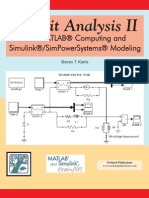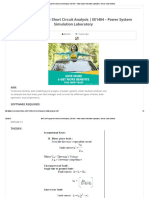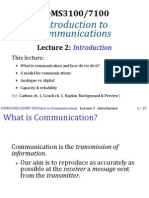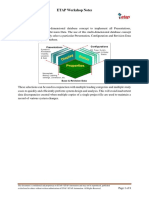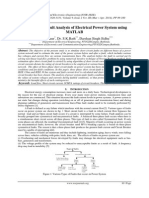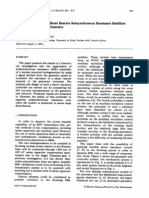EEL303: Power Engineering I - Tutorial 7
Uploaded by
vikey1116EEL303: Power Engineering I - Tutorial 7
Uploaded by
vikey1116EEL303: Power Engineering I - Tutorial 7
1. A voltage of 100 2sin(314t + ) is applied to a series RL circuit by closing a switch.
R=10ohm and L=0.1H.
(a) What is the maximum possible value of DC component of current that can occur.
(b) If the switch is closed at an instant such that the DC component of current is zero,
what is the instantaneous value of voltage at the time of closing of a switch.
(c) If the switch is closed when the instantaneous voltage is zero, find the instantaneous
current 5 seconds later.
[Ans: (a)4.2915A (b)134.75V (c)-4.089A]
Solution:
i(t) =
Vmax
|Z|
Rt
sin(t + ) e L sin( )
Vmax
sin(t + )
|Z|
Rt
Vmax
itr (t) =
e L sin( )
|Z|
|Z| = R2 + (L)2 = (10)2 + (314 0.1)2 = 32.954ohm
)
(
)
(
314 0.1
L
1
1
= tan
= 72.3350
= tan
R
10
iss (t) =
(a) DC component of current (or) transient term will have its maximum value when
( ) = and t=0.
2
Vmax
100 2
=
= 4.2915A
|Z|
32.954
(b) DC component of current will be zero, when ( )
At the instant of closing switch (t=0),
v(t) = 100 2sin(72.3350 ) = 134.75V
(c)
v(t) = 100 2sin(314t + ) = 0
= = 314t
At t=5sec, = 314 5 = 1570
]
100 2 [
i(t) =
sin(72.335) e1005 sin(1570 72.335) = 4.089A
32.954
Electrical Engineering Dept - IIT Delhi
EEL303: Power Engineering I - Tutorial 7
2. A generator rated 100MVA, 18KV with reactances of xd = 19%, xd = 26%, xd = 130%
is connected to a transformer. The transformer is rated 100MVA, 240 star/18 delta KV,
x = 10%. If a three phase short circuit occurs on the high voltage side of the transformer
at rated voltage and no load, find
(a) The initial symmetrical RMS current in the transformer winding on the high voltage
side.
(b) The initial symmetrical RMS current in the line on low voltage side.
[Ans: (a)829.5A (b)11,060A]
Solution:
I =
1.0
= j3.448p.u
j(0.19 + 0.10)
100 1000
= 240.6A
BaseIHV =
3 240
100 1000
BaseILV =
= 3207.5A
3 18
(a) 3.448 240.6 = 829.5A
(b) 3.448 3207.5 = 11,060A
3. A generator is connected through a transformer to a synchronous motor. Reduced to
the same base, the p.u sub-transient reactances of the generator and motor are 0.15 and
0.35 respectively. and leakage reactance of transformer is 0.1p.u. A three phase fault
occurs at terminals of motor when terminal voltage of generator is 0.9p.u and output
current of generator is 1.0p.u at 0.8pf leading. Find sub-transient current in p.u in fault,
in generator and in motor. Use terminal voltage of generator as reference phasor and
obtain solution using thevenins theorem. [Ans: Ig = 0.48-j3.24 p.u; Im = -1.03-j3.34
p.u]
Solution:
Vf = 0.9 (0.8 + j0.6)(j0.1) = 0.96 j0.08p.u
j0.25 j0.35
Zth =
= j0.146p.u
j0.60
0.96 j0.08
= 0.55 j6.58p.u
If =
j0.146
By replacing If by a current source and then applying the principle of superposition
Ig = 0.8 + j0.6 +
j0.35
(0.55 j6.58) = 0.48 j3.24p.u
j0.6
Electrical Engineering Dept - IIT Delhi
EEL303: Power Engineering I - Tutorial 7
Im = 0.8 j0.6 +
j0.25
(0.55 j6.58) = 1.03 j3.34p.u
j0.6
4. The one-line diagram of three phase power system is as shown: Each generator is repre-
Figure 1:
sented by an emf behind the sub-transient reactance. All impedances are expressed in
p.u on common MVA base. All resistances and shunt capacitances are neglected. The
generators are operating on no-load at their rated voltage with their emfs in phase. A
three phase fault occurs at bus 3 through fault impedance Zf =j0.19p.u.
(a) Using Thevenins theorem obtain the impedance to the point of fault and fault
current in p.u.
(b) Determine the bus voltages and line currents during fault.
[Ans: (a) Z33 =j0.2102; If = -j2.4988 p.u (b) V1f = 0.925p.u; V2f = 0.925p.u; V3f =
f
f
f
0.4748p.u; I12
= 0; I13
= -j1.5007p.u; I33
= -j1.0004p.u]
Solution: z12 = j0.75, z10 = j0.05, z20 = j0.075, z13 = j0.3, z23 = j0.45
y12 = -j1.33, y10 = -j20, y20 = -13.33j, y13 = -3.33j, y23 = -2.22j
YBus
24.66j
1.33j
3.33j
16.88j 2.22j
= 1.33j
3.33j
2.22j
5.55j
YBus
= l21 1
l31 l32
u11 u12 u13
0 u22 u23
0
0
0 u33
1
0
u11 = -24.66j; u12 = 1.33j; u13 = 3.33j
Electrical Engineering Dept - IIT Delhi
EEL303: Power Engineering I - Tutorial 7
l21 u11 = 1.33j = l21 = -0.0539
l21 u12 + u22 = -16.88i = u22 = -16.8083j
l21 u13 + u23 = 2.22j = u23 = 2.3994j
l31 u11 = 3.33j = l31 = -0.1350
l31 u12 + l32 u22 = 2.22j = l32 =-0.1428
l31 u13 + l32 u23 + u33 = -5.55j = u33 =-4.7578j
Y = LU
24.66j
1.33j
3.33j
Z13
0
0.0539
1
0
16.8083j 2.3994j
0
Z23 = 0
0.1350 0.1428 1
0
0
4.7578j Z33
1
1
X1
0
0.0539
1
0
X2 = 0
0.1350 0.1428 1 X3
1
1
X1 = 0
0.05X1 + X2 = 0 = X2 =0
X3 = 1
24.66j
1.33j
3.33j
Z13
0
0
16.8083j 2.3994j
Z23 = 0
0
0
4.7578j Z33
1
(-4.7578j)(Z33 )=1 = Z33 = 0.2102j;
(16.8083j)(Z23 ) + (2.3994j)(Z33 ) = 0 = Z23 = 0.03j
(24.66j)(Z13 ) + (1.33j)(Z23 ) + (3.33j)(Z33 ) = 0 = Z13 = 0.03j
If =
1
V30
=
= 2.4988j
Z33 + Zf
0.2102j + 0.19j
Vif = Vi0
Zi3
V30
Z33 + Zf
Electrical Engineering Dept - IIT Delhi
EEL303: Power Engineering I - Tutorial 7
V1f = V10
0.03j
Z13
V30 = 1
1 = 0.925p.u
Z33 + Zf
j0.4002
V2f = V20
0.03j
Z23
V30 = 1
1 = 0.925p.u
Z33 + Zf
j0.4002
V3f = If Zf = (2.4988j)(0.19j) = 0.4748p.u
Iijf
f
I12
=
Vif Vjf
=
zij
V1f V2f
0.925 0.925
=
=0
z12
0.75j
f
I13
V1f V3f
0.925 0.4748
=
=
= 1.5007jp.u
z13
j0.3
f
I23
V2f V3f
0.925 0.4748
=
=
= 1.0004jp.u
z23
j0.45
Electrical Engineering Dept - IIT Delhi
You might also like
- Simulation of Some Power System, Control System and Power Electronics Case Studies Using Matlab and PowerWorld SimulatorFrom EverandSimulation of Some Power System, Control System and Power Electronics Case Studies Using Matlab and PowerWorld SimulatorNo ratings yet
- Steps For Generationplant - Ts - Sample1: Etap Workshop Notes ©1996-2009 Operation Technology, Inc. Page 1 of 2No ratings yetSteps For Generationplant - Ts - Sample1: Etap Workshop Notes ©1996-2009 Operation Technology, Inc. Page 1 of 22 pages
- Circuit Analysis II Using MATLAB SimulationNo ratings yetCircuit Analysis II Using MATLAB Simulation678 pages
- Creating A One-Line Diagram (IEC) : Purpose & DescriptionNo ratings yetCreating A One-Line Diagram (IEC) : Purpose & Description5 pages
- EEL303: Power Engineering I - Tutorial 5No ratings yetEEL303: Power Engineering I - Tutorial 57 pages
- MD Singh Power Electronics Solution Manual To Chapter 15No ratings yetMD Singh Power Electronics Solution Manual To Chapter 1515 pages
- Lecture 14 Transient Stability SolutionsNo ratings yetLecture 14 Transient Stability Solutions39 pages
- Short Circuit Analysis of Ieee 14-Bus SystemNo ratings yetShort Circuit Analysis of Ieee 14-Bus System5 pages
- © 1996-2009 Operation Technology, Inc. - Workshop Notes: Cable PullingNo ratings yet© 1996-2009 Operation Technology, Inc. - Workshop Notes: Cable Pulling17 pages
- "220 KV GSS, Ig Nagar, Jaipur": Industrial Training ReportNo ratings yet"220 KV GSS, Ig Nagar, Jaipur": Industrial Training Report50 pages
- IEC - Short-Circuit Example 2: DescriptionNo ratings yetIEC - Short-Circuit Example 2: Description9 pages
- A Survey of Frequency and Voltage Control Ancillary ServicesPart I Technical FeaturesNo ratings yetA Survey of Frequency and Voltage Control Ancillary ServicesPart I Technical Features8 pages
- Dynamic Modeling of Diesel Generator Based On Electrical and Mechanical AspectsNo ratings yetDynamic Modeling of Diesel Generator Based On Electrical and Mechanical Aspects7 pages
- Transient Stability Example 1: ObjectivesNo ratings yetTransient Stability Example 1: Objectives7 pages
- Impedance Adjustment For Synchronous Machine PDFNo ratings yetImpedance Adjustment For Synchronous Machine PDF1 page
- ETAP Workshop Notes 3D Database: Theoretical ConceptsNo ratings yetETAP Workshop Notes 3D Database: Theoretical Concepts8 pages
- PowerFactory 2020 Product SpecificationNo ratings yetPowerFactory 2020 Product Specification12 pages
- Short Circuit Fault Analysis of Electrical Power System Using MATLAB100% (3)Short Circuit Fault Analysis of Electrical Power System Using MATLAB12 pages
- Arc Flash Exercise 2: Purpose & DescriptionNo ratings yetArc Flash Exercise 2: Purpose & Description4 pages
- Project On Three Phase Fault Analysis With Auto Reset On Temporary Fault and Permanent Trip OtherwiseNo ratings yetProject On Three Phase Fault Analysis With Auto Reset On Temporary Fault and Permanent Trip Otherwise106 pages
- Operational Characteristics of A Filtering Rectifier Transformer For Industrial Power SystemsNo ratings yetOperational Characteristics of A Filtering Rectifier Transformer For Industrial Power Systems12 pages
- Theoretical Study of A Shunt Reactor Sub Synchronous Resonance StabilizerNo ratings yetTheoretical Study of A Shunt Reactor Sub Synchronous Resonance Stabilizer14 pages
- Edp02 Coordinación Selectiva de Sobrecorriente en BTNo ratings yetEdp02 Coordinación Selectiva de Sobrecorriente en BT22 pages
- Power System Protection: Fault AnalysisNo ratings yetPower System Protection: Fault Analysis41 pages
- Ee6002 Power System Transients: Part-A Important Questions For May/June-2016No ratings yetEe6002 Power System Transients: Part-A Important Questions For May/June-20161 page
- Cablesizer - Cable Sizing Calculations To IEC and NEC Standards3No ratings yetCablesizer - Cable Sizing Calculations To IEC and NEC Standards31 page
- Simulation of Some Power System, Control System and Power Electronics Case Studies Using Matlab and PowerWorld SimulatorFrom EverandSimulation of Some Power System, Control System and Power Electronics Case Studies Using Matlab and PowerWorld Simulator
- Steps For Generationplant - Ts - Sample1: Etap Workshop Notes ©1996-2009 Operation Technology, Inc. Page 1 of 2Steps For Generationplant - Ts - Sample1: Etap Workshop Notes ©1996-2009 Operation Technology, Inc. Page 1 of 2
- Creating A One-Line Diagram (IEC) : Purpose & DescriptionCreating A One-Line Diagram (IEC) : Purpose & Description
- MD Singh Power Electronics Solution Manual To Chapter 15MD Singh Power Electronics Solution Manual To Chapter 15
- © 1996-2009 Operation Technology, Inc. - Workshop Notes: Cable Pulling© 1996-2009 Operation Technology, Inc. - Workshop Notes: Cable Pulling
- "220 KV GSS, Ig Nagar, Jaipur": Industrial Training Report"220 KV GSS, Ig Nagar, Jaipur": Industrial Training Report
- A Survey of Frequency and Voltage Control Ancillary ServicesPart I Technical FeaturesA Survey of Frequency and Voltage Control Ancillary ServicesPart I Technical Features
- Dynamic Modeling of Diesel Generator Based On Electrical and Mechanical AspectsDynamic Modeling of Diesel Generator Based On Electrical and Mechanical Aspects
- ETAP Workshop Notes 3D Database: Theoretical ConceptsETAP Workshop Notes 3D Database: Theoretical Concepts
- Short Circuit Fault Analysis of Electrical Power System Using MATLABShort Circuit Fault Analysis of Electrical Power System Using MATLAB
- Project On Three Phase Fault Analysis With Auto Reset On Temporary Fault and Permanent Trip OtherwiseProject On Three Phase Fault Analysis With Auto Reset On Temporary Fault and Permanent Trip Otherwise
- Operational Characteristics of A Filtering Rectifier Transformer For Industrial Power SystemsOperational Characteristics of A Filtering Rectifier Transformer For Industrial Power Systems
- Theoretical Study of A Shunt Reactor Sub Synchronous Resonance StabilizerTheoretical Study of A Shunt Reactor Sub Synchronous Resonance Stabilizer
- Edp02 Coordinación Selectiva de Sobrecorriente en BTEdp02 Coordinación Selectiva de Sobrecorriente en BT
- Ee6002 Power System Transients: Part-A Important Questions For May/June-2016Ee6002 Power System Transients: Part-A Important Questions For May/June-2016
- Cablesizer - Cable Sizing Calculations To IEC and NEC Standards3Cablesizer - Cable Sizing Calculations To IEC and NEC Standards3
- Computer Aided Design of Electrical MachinesFrom EverandComputer Aided Design of Electrical Machines
- Power System Wide-area Stability Analysis and ControlFrom EverandPower System Wide-area Stability Analysis and Control




